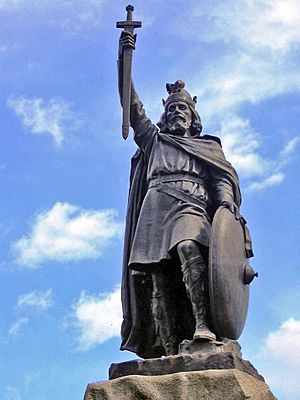Treaty of Wedmore facts for kids
The Treaty of Wedmore was an important agreement made in the 9th century. It was signed between Alfred the Great, who was the King of Wessex, and Guthrum the Old, a powerful Viking king. This treaty helped bring peace after a big battle.
The only record we have of this treaty comes from a Welsh monk named Asser. He wrote a book about Alfred's life called Vita Ælfredi regis Angul Saxonum, or "The Life of Alfred". Asser explained that after Alfred defeated Guthrum at the Battle of Edington, Guthrum agreed to a peace treaty.
A key part of the treaty was that Guthrum had to be baptised. This helped make the agreement stronger. It also allowed Guthrum to rule more easily over the Christian people in his lands. After the treaty, Guthrum and his Viking army had to leave Wessex.
Why the Treaty Was Needed
In the year 878, King Alfred of Wessex fought against a large Viking army. Alfred's army won a major victory at the Battle of Edington. After this defeat, Guthrum, the Viking leader, and his remaining soldiers went to their stronghold. King Alfred then surrounded them.
After two weeks, the Vikings were very hungry, cold, and scared. Asser wrote that they finally asked for peace. They agreed that King Alfred could take as many hostages as he wanted from them. They would not ask for any hostages in return.
Alfred accepted Guthrum's surrender. The Vikings gave Alfred people as a promise of peace. They also swore they would leave Alfred's kingdom right away. Guthrum, their king, promised to become a Christian and be baptised by King Alfred. Asser wrote that Guthrum and his men kept all their promises.
Guthrum's Baptism and New Life
Three weeks later, Guthrum and thirty of his most important men met Alfred. This meeting happened at a place called Aller, near Athelney. There, Guthrum was baptised. King Alfred even became Guthrum's adoptive father.
Eight days later, a special part of the baptism ceremony happened. This took place at the royal estate and church in Wedmore, close to Cheddar. Guthrum was given a new Christian name: Athelstan. For the next twelve days, Guthrum and his chiefs stayed with Alfred. They were given gifts and enjoyed big feasts.
During the summer of 878, Guthrum's army stayed in Chippenham. Then, as they had agreed, Guthrum and his army left Wessex. They traveled to Cirencester, which was in the Kingdom of Mercia. Eventually, they moved on to East Anglia.
Understanding the Treaties
The Anglo-Saxon Chronicle, another old historical record, tells a similar story to Asser's. It describes Alfred's actions before and after the Battle of Edington. It also talks about Guthrum's surrender, his baptism at Wedmore, and the twelve days of celebration.
The only mention of an agreement made at Wedmore is from Asser's "Life of Alfred". If there was a formal written treaty at Wedmore in 878, it does not exist today. It is believed that the agreement at Wedmore was a spoken promise.
Later on, a more formal written agreement was made. This one is known as the Treaty of Alfred and Guthrum. This document still exists today. It clearly set the borders between Alfred's lands and Guthrum's territories. It also included rules for peaceful trade and how much money should be paid if someone was harmed (called weregild). This treaty was an important step towards creating the Danelaw. The Danelaw was an area in England where Viking laws and customs were followed.
People have often mixed up the Treaty of Wedmore and the Treaty of Alfred and Guthrum. The Treaty of Wedmore in 878 was likely a verbal agreement. It mainly focused on Guthrum's baptism and his army leaving Wessex. The formal, written Treaty of Alfred and Guthrum, which divided the kingdoms, came a few years later.


